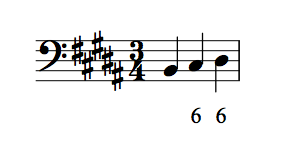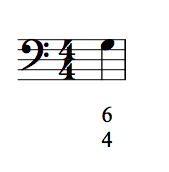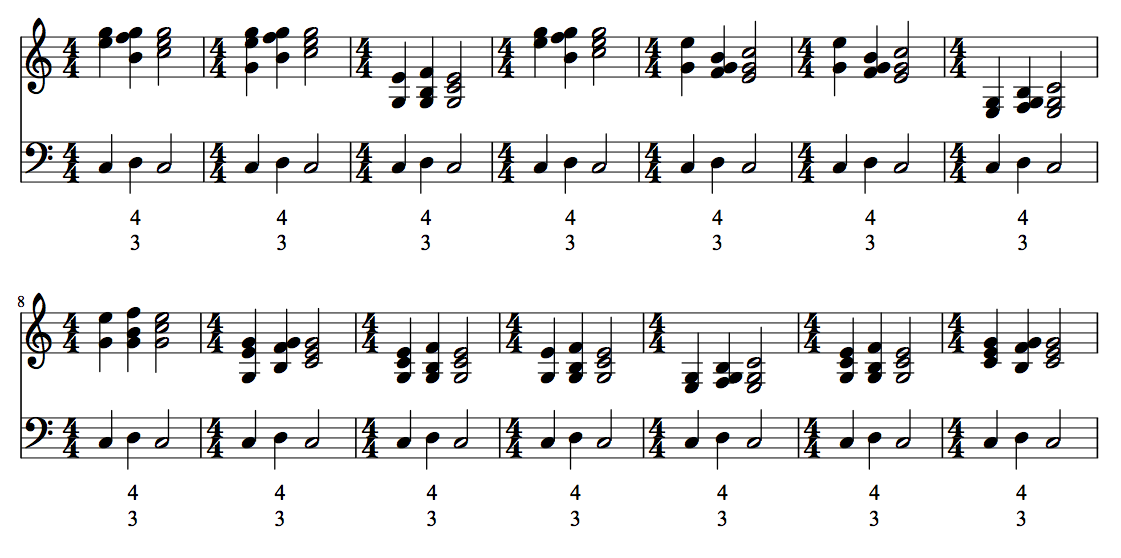music21.figuredBass.realizer¶
This module, the heart of fbRealizer, is all about realizing
a bass line of (bassNote, notationString)
pairs. All it takes to create well-formed realizations of a
bass line is a few lines of music21 code,
from start to finish. See FiguredBassLine for more details.
>>> from music21.figuredBass import realizer
>>> fbLine = realizer.FiguredBassLine()
>>> fbLine.addElement(note.Note('C3'))
>>> fbLine.addElement(note.Note('D3'), '4,3')
>>> fbLine.addElement(note.Note('C3', quarterLength = 2.0))
>>> allSols = fbLine.realize()
>>> allSols.getNumSolutions()
30
>>> allSols.generateRandomRealizations(14).show()
The same can be accomplished by taking the notes and notations
from a Stream.
See figuredBassFromStream() for more details.
>>> s = converter.parse('tinynotation: C4 D4_4,3 C2', makeNotation=False)
>>> fbLine = realizer.figuredBassFromStream(s)
>>> allSols2 = fbLine.realize()
>>> allSols2.getNumSolutions()
30
FiguredBassLine¶
- class music21.figuredBass.realizer.FiguredBassLine(inKey=None, inTime=None)¶
A FiguredBassLine is an interface for realization of a line of (bassNote, notationString) pairs. Currently, only 1:1 realization is supported, meaning that every bassNote is realized and the
quarterLengthor duration of a realization above a bassNote is identical to that of the bassNote.inKey defaults to C major.
inTime defaults to 4/4.
>>> from music21.figuredBass import realizer >>> fbLine = realizer.FiguredBassLine(key.Key('B'), meter.TimeSignature('3/4')) >>> fbLine.inKey <music21.key.Key of B major> >>> fbLine.inTime <music21.meter.TimeSignature 3/4>
FiguredBassLine methods
- FiguredBassLine.addElement(bassObject: Note, notationString=None)¶
Use this method to add (bassNote, notationString) pairs to the bass line. Elements are realized in the order they are added.
>>> from music21.figuredBass import realizer >>> fbLine = realizer.FiguredBassLine(key.Key('B'), meter.TimeSignature('3/4')) >>> fbLine.addElement(note.Note('B2')) >>> fbLine.addElement(note.Note('C#3'), '6') >>> fbLine.addElement(note.Note('D#3'), '6') >>> fbLine.generateBassLine().show()

- FiguredBassLine.generateBassLine()¶
Generates the bass line as a
Score.>>> from music21.figuredBass import realizer >>> fbLine = realizer.FiguredBassLine(key.Key('B'), meter.TimeSignature('3/4')) >>> fbLine.addElement(note.Note('B2')) >>> fbLine.addElement(note.Note('C#3'), '6') >>> fbLine.addElement(note.Note('D#3'), '6') >>> fbLine.generateBassLine().show()

>>> sBach = corpus.parse('bach/bwv307') >>> sBach.parts.last().measure(0).show('text') {0.0} ... {0.0} <music21.clef.BassClef> {0.0} <music21.key.Key of B- major> {0.0} <music21.meter.TimeSignature 4/4> {0.0} <music21.note.Note B-> {0.5} <music21.note.Note C>
>>> fbLine = realizer.figuredBassFromStream(sBach.parts.last()) >>> fbLine.generateBassLine().measure(1).show('text') {0.0} <music21.clef.BassClef> {0.0} <music21.key.KeySignature of 2 flats> {0.0} <music21.meter.TimeSignature 4/4> {3.0} <music21.note.Note B-> {3.5} <music21.note.Note C>
- FiguredBassLine.overlayPart(music21Part)¶
- FiguredBassLine.realize(fbRules=None, numParts=4, maxPitch=None)¶
Creates a
Segmentfor each (bassNote, notationString) pair added usingaddElement(). Each Segment is associated with theRulesobject provided, meaning that rules are universally applied across all Segments. The number of parts in a realization (including the bass) can be controlled through numParts, and the maximum pitch can likewise be controlled through maxPitch. Returns aRealization.If this method is called without having provided any (bassNote, notationString) pairs, a FiguredBassLineException is raised. If only one pair is provided, the Realization will contain
allCorrectConsecutivePossibilities()for the one note.if fbRules is None, creates a new rules.Rules() object
if maxPitch is None, uses pitch.Pitch(‘B5’)
>>> from music21.figuredBass import realizer >>> from music21.figuredBass import rules >>> fbLine = realizer.FiguredBassLine(key.Key('B'), meter.TimeSignature('3/4')) >>> fbLine.addElement(note.Note('B2')) >>> fbLine.addElement(note.Note('C#3'), '6') >>> fbLine.addElement(note.Note('D#3'), '6') >>> fbRules = rules.Rules() >>> r1 = fbLine.realize(fbRules) >>> r1.getNumSolutions() 208 >>> fbRules.forbidVoiceOverlap = False >>> r2 = fbLine.realize(fbRules) >>> r2.getNumSolutions() 7908
- FiguredBassLine.retrieveSegments(fbRules=None, numParts=4, maxPitch=None)¶
generates the segmentList from an fbList, including any overlaid Segments
if fbRules is None, creates a new rules.Rules() object
if maxPitch is None, uses pitch.Pitch(‘B5’)
FiguredBassLine instance variables
- FiguredBassLine.inKey¶
A
Keywhich implies a scale value, scale mode, and key signature for aFiguredBassScale.
- FiguredBassLine.inTime¶
A
TimeSignaturewhich specifies the time signature of realizations outputted to aScore.
Realization¶
- class music21.figuredBass.realizer.Realization(**fbLineOutputs)¶
Returned by
FiguredBassLineafter callingrealize(). Allows for the generation of realizations as aScore.See the
examplesmodule for examples on the generation of realizations.A possibility progression is a valid progression through a string of
Segmentinstances. Seepossibilityfor more details on possibilities.
Realization methods
- Realization.generateAllRealizations()¶
Generates all unique realizations as a
Score.Warning
This method is unoptimized, and may take a prohibitive amount of time for a Realization which has more than 100 solutions.
- Realization.generateRandomRealization()¶
Generates a random unique realization as a
Score.
- Realization.generateRandomRealizations(amountToGenerate=20)¶
Generates amountToGenerate unique realizations as a
Score.Warning
This method is unoptimized, and may take a prohibitive amount of time if amountToGenerate is more than 100.
- Realization.generateRealizationFromPossibilityProgression(possibilityProgression)¶
Generates a realization as a
Scoregiven a possibility progression.
- Realization.getAllPossibilityProgressions()¶
Compiles each unique possibility progression, adding it to a master list. Returns the master list.
Warning
This method is unoptimized, and may take a prohibitive amount of time for a Realization which has more than 200,000 solutions.
- Realization.getNumSolutions()¶
Returns the number of solutions (unique realizations) to a Realization by calculating the total number of paths through a string of
Segmentmovements. This is faster and more efficient than compiling each unique realization into a list, adding it to a master list, and then taking the length of the master list.>>> from music21.figuredBass import examples >>> fbLine = examples.exampleB() >>> fbRealization = fbLine.realize() >>> fbRealization.getNumSolutions() 422 >>> fbLine2 = examples.exampleC() >>> fbRealization2 = fbLine2.realize() >>> fbRealization2.getNumSolutions() 833
- Realization.getRandomPossibilityProgression()¶
Returns a random unique possibility progression.
Realization instance variables
- Realization.keyboardStyleOutput¶
True by default. If True, generated realizations are represented in keyboard style, with two staves. If False, realizations are represented in chorale style with n staves, where n is the number of parts. SATB if n = 4.
Functions¶
- music21.figuredBass.realizer.figuredBassFromStream(streamPart: Stream) FiguredBassLine¶
Takes a
Part(or anotherStreamsubclass) and returns aFiguredBassLineobject whose bass notes have notations taken from the lyrics in the source stream. This method along with therealize()method provide the easiest way of converting from a notated version of a figured bass (such as in a MusicXML file) to a realized version of the same line.>>> s = converter.parse('tinynotation: 4/4 C4 D8_6 E8_6 F4 G4_7 c1', makeNotation=False) >>> fb = figuredBass.realizer.figuredBassFromStream(s) >>> fb <music21.figuredBass.realizer.FiguredBassLine object at 0x...>
>>> fbRules = figuredBass.rules.Rules() >>> fbRules.partMovementLimits = [(1, 2), (2, 12), (3, 12)] >>> fbRealization = fb.realize(fbRules) >>> fbRealization.getNumSolutions() 13 >>> fbRealization.generateRandomRealizations(8).show()

Changed in v7.3: multiple figures in same lyric (e.g. ‘64’) now supported.
- music21.figuredBass.realizer.addLyricsToBassNote(bassNote, notationString=None)¶
Takes in a bassNote and a corresponding notationString as arguments. Adds the parsed notationString as lyrics to the bassNote, which is useful when displaying the figured bass in external software.
>>> from music21.figuredBass import realizer >>> n1 = note.Note('G3') >>> realizer.addLyricsToBassNote(n1, '6,4') >>> n1.lyrics[0].text '6' >>> n1.lyrics[1].text '4' >>> n1.show()

